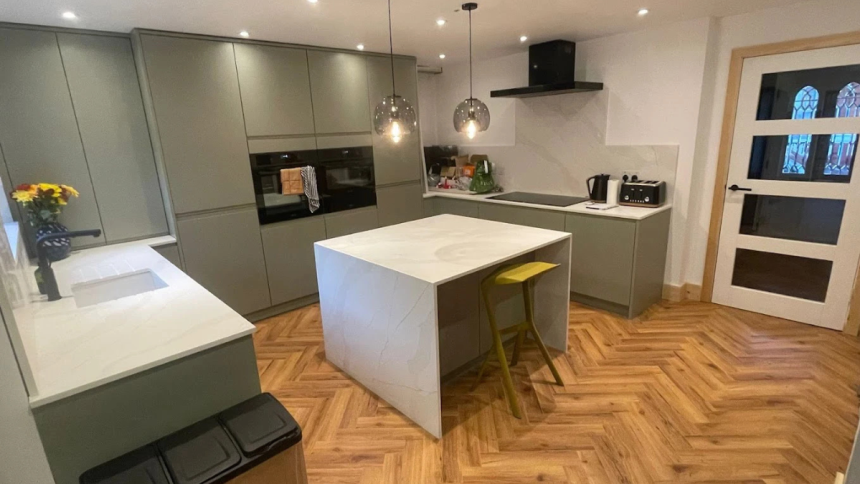You find yourself in your kitchen, gazing at a chilly, cracked tile that has been subjected to too many accidents. Suddenly, you wonder: Can I install laminate flooring in here?” Honestly, it’s a question worthy of serious thought. To assist you in deciding if laminate flooring is suitable for your kitchen, the following are some vital facts regarding it.
Overview of Laminate Floors
Laminate flooring is made of layers. You’ve got a sturdy fibreboard core, topped with a photographic layer, literally a picture of wood, tile, or stone), and then a clear protective layer to keep the material safe from accidents.
It looks the business. It’s less pricey than hardwood. And it can go in a kitchen but with some caveats.
Water, Spills, and More
Here’s where things get a bit tricky. Kitchens are, by nature, wet places. Boiling pasta bubbles over, wine gets splashed when you get too enthusiastic, and the dishwasher might one day break all of a sudden.
Traditional laminate isn’t waterproof—it’s water-resistant. What does it mean? If water seeps into the seams, it can cause the boards to swell, buckle, and generally incur some unpleasant results.
That said, not all laminate is created equal. There are now waterproof or water-resistant laminate options on the market. If you’re going to laminate your kitchen, go for the tough choices. It’ll cost a bit more, but it won’t dissolve under pressure.
A Matter of Aesthetics
There’s no denying it, laminate flooring looks fabulous. It can mimic anything from rustic oak to sleek slate. It gives your kitchen that Instagrammable vibe without needing a major overhaul.
Plus, it’s warmer underfoot than tiles, making it the perfect choice for those who don’t want their goes getting cold. The material is also much kinder on your knees if you spend half your time bending down to retrieve whatever you just dropped.
Aesthetically? Laminate is a solid 9 out of 10.
Easy Installation (for Those Who Don’t Fear a DIY Weekend)
For the brave souls who think assembling flat-pack furniture is a bonding experience, laminate is a dream. It clicks together like Lego for grown-ups. No glue, no grout, and not a lot of unnecessary fuss.
Even if you’re hiring a pro, the labour cost is less than with the complex ceramic tiles. So, win-win.
Verdict: Yes, Laminate Flooring is Good for Kitchens, But With Caution
Can you use laminate flooring in your kitchen, then? Absolutely. Just be sure to pick one that is waterproof or water resistant, has well-sealed joints, and has a decent guarantee. Watch out for naughty equipment and try to wipe up spills as quickly as possible.
In the end, laminate adds coziness, style, and affordability to your kitchen. Simply handle it with the same consideration as any other fixture in your house: be kind, set limits, and ideally keep it dry.
If you are looking to purchase laminate flooring, we would recommend Flooring Factory, who have a range of stock designs and styles to choose from. They offer premium quality flooring at factory prices.
Lynn Martelli is an editor at Readability. She received her MFA in Creative Writing from Antioch University and has worked as an editor for over 10 years. Lynn has edited a wide variety of books, including fiction, non-fiction, memoirs, and more. In her free time, Lynn enjoys reading, writing, and spending time with her family and friends.















